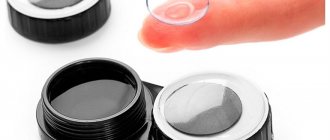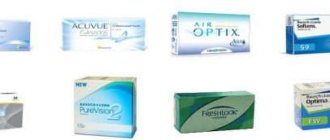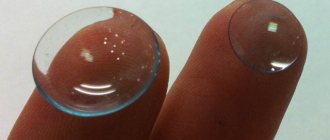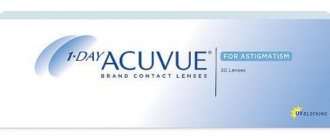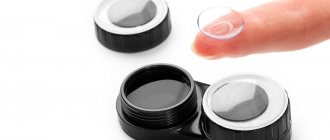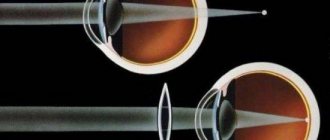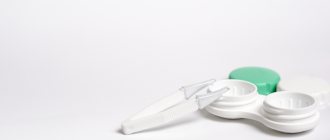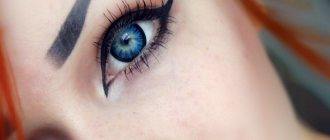There is an idea that short periods of wearing (in other words, replacement) are specifically indicated for contact lenses: this way, users will more often buy new ones. But the fact is that the time specified by the manufacturer really cannot be ignored. Imagine that on your eye, in direct contact with it, there is a foreign body, made of a material unknown to you, with properties unknown to you. You don’t know what will happen to the eye after prolonged contact with this body. But it is known to the manufacturer. Therefore, he limits the period of wearing the lens depending on its properties. Therefore, you need to strictly follow the rules of storage and cleaning: how, in what solution to store lenses, how to wash the container, how often to change the solution, etc.
Classification of lenses by wear period
When purchasing contact optics, you should first of all pay attention to the recommendations from the manufacturer regarding the timing of its wearing.
Depending on this indicator, all models are divided into products intended for long-term wear, for daily or weekly replacement. There are also models that are used only at night. Lenses that can be worn for a long time are divided into two types:
- Rigid gas permeable.
- Products made of silicone hydrogel.
Hard
https://www.youtube.com/watch?v=ytdevru
Lenses made of hard materials are more durable and durable than soft ones, as well as highly resistant to the formation of protein deposits on their surface. As a rule, they are used by people who require correction of severe vision deviations - myopia, farsightedness, astigmatism.
Other advantages of rigid optics include:
- relatively low cost;
- taking into account individual parameters (corneal curvature, size, visual acuity) during production for each client;
- the ability to use the product for several years if the rules of care are followed;
- higher quality of correction of vision deviations.
The disadvantages of rigid CLs are:
- Need for daily care.
- Longer adaptation period.
- Possibility of lenses shifting and falling out when making sudden movements. This occurs due to the small diameter of products made from hard materials.
- Danger of penetration of dust and other small particles that irritate the cornea.
Some models of long-term silicone hydrogel contact lenses can be left in place for 30 days. This is possible thanks to the use of special materials that are flexible, soft, perfectly allow air to pass to the cornea and prevent the development of oxygen starvation of the eyes.
Most often, such lenses are used by people who travel frequently. After all, changing optics requires sterile conditions, which are not available in a train, car, or plane.
Long-term soft contact lenses are made only from silicone hydrogel. Conventional hydrogel lenses when worn for a long time (more than 16 hours) will certainly cause discomfort in the eyes. The advantage of silicone hydrogel is not only excellent oxygen permeability, but also high moisture content in its composition.
Some models have a moisture content of 80%. Thanks to this, the product does not allow the surface of the eye to dry out, and, accordingly, the person will not suffer from dryness and irritation. Some models are equipped with a UV filter, which allows you to protect your eyes from the negative effects of sunlight.
It must be taken into account that, despite the possibility of long-term continuous use, such models are still recommended to be removed periodically to give the eyes a chance to rest.
Wearing contact lenses longer than the period specified by the manufacturer can lead to the following unpleasant symptoms:
- dryness;
- redness;
- feeling of sand in the eyes;
- blurred vision;
- development of bacterial infectious diseases;
- burning, stinging in the eyes;
- increased lacrimation.
Colored lenses presented on the modern optics market have different service life. The safest for the health of the visual organs are one-day models. Their advantage is that they can only be used during the day. Thanks to this, the lenses do not accumulate protein and lipid deposits on their surface, which means they are absolutely safe for the eyes. Before going to bed, simply remove the optical products and dispose of them. How long can you wear daily lenses?
Despite the many advantages of colored daily lenses, their disadvantage is still their rather high cost. This is why many people prefer to use other lens models designed for longer use. As you probably guessed, we are talking about beauty models of planned replacement, namely, lenses designed to be worn for three months.
Contact lenses or glasses?
At first glance, it may seem that glasses and contact lenses are competitors. This is wrong. If your vision is weakened by a couple of diopters, and you use glasses in the theater, cinema, or when viewing very distant objects, then you don’t have to think about lenses.
But there is a significant group of bespectacled people for whom lenses are preferable. For example, those visually impaired whose myopia has exceeded 10 diopters. Most often, glasses are powerless to provide them with 100% vision. But even if they cope with this, the poor bespectacled people are doomed to wear heavy glasses with thick lenses. These glasses are quite heavy and often rub the ears and bridge of the nose. In them, the eye sees clearly only in the forward direction, along the edge - the image is slightly deformed. And if you squint your eyes to the right or left, beyond the spectacle lens, it will be absolutely impossible to make out anything but fog. So, for the visually impaired, contact lenses are tantamount to a second birth: they get rid of ugly glasses and give amazing visual acuity, opening up peripheral vision.
Don't forget about the cosmetic effect - glasses with strong lenses are not decorative. A far-sighted eye, covered with glass, looks unnaturally huge, and a near-sighted eye looks inexpressively small. Often, such glasses become the cause of complexes. A visually impaired person (especially if the visual defect was acquired a long time ago) who tries on the lenses, seems to be getting acquainted with the world for the first time - the image of the surrounding environment is so bright and clear.
Lenses have advantages over glasses not only with a high degree of myopia or farsightedness, but also with diseases such as astigmatism and differences in eye refraction, when the visual acuity of the eyes differs by more than two to three diopters.
How to choose lenses
If you decide to exchange glasses for contact lenses, then immediately go to an ophthalmologist or contact specialist. Most modern clinics use computer diagnostics to select lenses. With properly selected lenses, your eyes feel light and comfortable. There are doctors who advise you to get used to lenses gradually. This is, of course, not bad. But from my own experience I know that lenses in which the eyes experience pain for longer than fifteen minutes are not for you. It's unlikely you'll be able to wear them. I'm talking about pain in the eyes, because mild nausea and a headache out of habit are phenomena that you just need to get used to. But your eyes shouldn't hurt.
Selecting lenses is a difficult and responsible matter. The lens should have a comfortable “fit.” Be sufficiently mobile and do not block free access to tear fluid. A fluid space consisting of clear tears should form between the lens and the cornea. A lens that is too tight does not allow tears to wash the cornea. That is why lenses should be selected individually, taking into account not only tolerance to the materials from which the lenses are made, but the shape and structure of the eye itself.
When choosing comfortable lenses, you need to remember three parameters: diopter power, base curvature of the cornea and lens diameter. Now, even without a doctor, you can change your lenses in any salon. The packaging of each lens contains the following symbols:
- DIA—lens diameter;
- BC—base curvature;
- D - dioptres (optical power of the lens).
The graphic image of the sun indicates that the lens contains ultraviolet protection, and the number next to the hourglass indicates the expiration date. The expiration date applies to unopened lenses. If you have opened the package, then the countdown has begun. Even if open lenses are stored in a sterile solution, two-week lenses will fail after the specified period. Lenses cannot be over-weared. This is dangerous due to such a serious disease as keratitis, that is, inflammation of the cornea.
Life in contact lenses
The world you look at through the lenses is characterized by brightness and contrasts. And to keep it that way longer, you should follow simple safety measures.
- Store lenses in a special sterile solution, which should be changed daily when removing lenses.
- Use only your own lenses, do not try on, and especially do not wear someone else’s.
- A dried lens that is not placed in the solution for some reason should be discarded immediately. It cannot be restored or soaked.
- When using any aerosol product: nail polish, deodorant, perfume, close your eyes tightly.
- Protect your eyes from all odors. You should not stay in a smoky or smoky room for a long time.
- Lenses must be worn before applying makeup. It is worth considering that water-based cosmetics damage lenses less than oily creams and lotions.
- If something gets on the lens or in the eye, the lens must be removed and washed with a solution.
- Eyes wearing lenses do not tolerate dust well. While cleaning, you should close your eyes with glasses with simple lenses.
The lens storage container must be kept clean. It is advisable to change it 3-4 times a year.
These rules should not be broken. But there are others that cannot be met so strictly. For example, a contact specialist in any country will advise: do not swim in lenses, limit wearing lenses during hot or cold weather, and avoid tears. These are, so to speak, optional rules.
I know a lot of people for whom lenses do not interfere with diving not only in the sea or in running river water, but also in a chlorinated pool. Temperatures from 25 minutes to plus 25 are tolerated normally by any eyes wearing lenses. Eyes covered with lenses react differently to severe frost and heat. Personally, mine don’t react at all. Equally as for tears. In ten years of wearing lenses, I have never “cried out” the lenses (although I know those to whom this has happened). On the contrary, my tears wash the lenses, after which you even feel better in them.
How to put on contact lenses
- Wash your hands with soap and dry them thoroughly - there should be no residual cream on your hands.
- Sit at the table - it will be easier to find an accidentally dropped lens.
- Open the container or blister in which the lens is stored.
- Remove the lens with your fingertips, being careful not to touch the lens with your nails. If you find it difficult to remove the lens with your fingers, you can use the rubber edge of a regular pipette or special small tweezers with plastic edges.
- Place the lens bottom down on the pad of your right index finger.
- Open your eye wide with the fingers of your left hand: lift the upper eyelid with your index finger, and pull down the lower eyelid with your thumb.
- Gently apply the lens to the center of the eye. Remove your hands from your eyes. Move your eye along the horizon: left and right. Blot your closed eye with a clean tissue. If your eyes are dry, put moisturizing drops for contact lenses, produced by various companies, into the eye with the lens. This procedure can be done several times during the day.
Eye and lens care
In the morning, it is useful to rinse your eyes in a solution of string or chamomile. To do this, brew the herb in the evening, pour it into special eye baths in the morning (they are sold in pharmacies), lower your eyes and blink in the water for at least a minute. A mini exercise for the eyes will also be beneficial. Exercises can be voluntary: rotation, squeezing and unclenching of the eyes, blinking.
In the evening, after removing the lenses, it is worth repeating the one-minute exercise. Periodically, you can instill a honey solution or any fortified drops. For example, French drops "Vitasik". They are used in regular courses: three times a year, for thirty days, with a break of three months.
Meanwhile, the lenses are placed in the solution. The most convenient thing is to use a solution - “two in one” or “all in one”, that is, designed for both washing and storing lenses. “Bausch and Lomb”, “Solo”, “Multiplus” products do not require additional cleaning products - tablets, shampoos. Johnson @ Johnson recently released the “Complete Comfort Plus” solution on the Russian market. It not only cleans the lenses, but also protects the eyes to some extent. The conditioner included in the solution envelops the lenses with an invisible protective film that moisturizes and protects the eyes throughout the day.
If you do not take care of your lenses, then protein, fat and salt deposits quickly form on their surface, and all sorts of microorganisms settle. All these “foreign bodies” can cause swelling, irritation and even ulcers of the cornea.
But it happens that lenses, which are carefully monitored, deteriorate before the time specified in the instructions. One of the reasons is the individual composition of tears. If there is a lot of protein in the tear, then the lenses last less.
How long do lenses last?
Today, contactology offers many types of lenses. Of the two main groups of lenses—hard and soft—soft contact lenses (SCLs) are the most popular.
There is a trend towards the appearance of lenses designed for short-term wear. However, all hygiene products that must be sterile have taken this course of development: disposable syringes, handkerchiefs, napkins, cotton swabs for cleaning ears. All sterile products are gradually becoming disposable.
The first lenses lasted 12 months. Then lenses appeared that corrected vision for six months. A few years ago, routine replacement lenses were invented. They served from one to three months. Today, the most comfortable lenses around the world are two-week and one-day lenses. You put these lenses on in the morning and throw them away in the evening. The next day, open a new blister with lenses. All the world's most famous types of daily lenses appeared in Russia: 1-Day Acuvue from JOHNSON & JOHNSON, SofLens One Day and Swiss Focus Dailies from CIBA VISION. The range of optical power of daily lenses is large enough to cover the widest range of patients: from +6.00 to -12.00 D.
Long live daily lenses!
I have no doubt that in ten years everyone who wears lenses will switch to daily use lenses. Today, the only limiting factor is their high cost.
Soft daily disposable contact lenses have advantages that ensure eye health:
- They are distinguished by a high degree of oxygen permeability, and, therefore, are easily tolerated even by the most sensitive eyes.
- They do not require any care. I took it off in the evening and threw it away without regret.
- Daily replacement eliminates the need to use damaged lenses.
- It is better to select lenses with the required parameters using disposable lenses - it is easier and cheaper.
- These lenses are convenient for those who go on a trip or business trip. It is not always convenient to manipulate sterile solutions and containers on the road or on a hike.
- Convenient for people who do without lenses in everyday life. Many of them periodically need 100% vision without glasses. For example, going to a football game. In such cases, they usually use soft contact lenses for scheduled replacement, which may be used only a couple of times in the allotted month.
- Finally, daily lenses are suitable for debut. Lenses are often damaged and lost in the early days - in the hands of an inexperienced former glasses wearer. In this case, it is easier to part with a one-day lens than one that was planned to be worn for six months.
Advice from someone who has been wearing lenses for a long time
- It is advisable to remove lenses at night, even those labeled as sleep-safe. Closed eyelids put pressure on the lens, disrupting the trophism and nutrition of the eye. Even if your eyes tolerate sleeping well in lenses, your morning face may appear wrinkled: bags under the eyes, puffiness and blueness.
- Sometimes your eyes require a break from lenses. The most reliable indicator is the iris, which surrounds any luminous object: a lit light bulb, a match flame, a street lamp, a car headlight. In this case, you need to remove the lenses for at least 20 minutes.
- If, when taking off your lenses at night, you notice that cloudy spots have appeared on them, then it’s time to think about new lenses - these will last a maximum of a week.
- I don't think lenses are needed for minor myopia. They don’t spoil the appearance, but they make the eyes a little duller, the look acquires a slight intensity. And if you believe that the eyes are the mirror of the soul, then the soul in this mirror seems sadder.
- For those who have poor vision, lenses are the most ingenious solution. True, for constant wear, I would choose slightly tinted lenses.
Eye color to match clothing color
Needless to say, how eye color changes facial expression? Our great-grandmothers’ generation loved to match their clothes to their eye color. Nowadays, you can do the opposite: match your “eyes” to your suit or hair color. I went to an optical salon and purchased colored lenses.
In some cases, colored lenses serve not only beauty. For example, they perfectly mask the absence of a pupil. This defect is called a thorn. A clear lens with a pupil dot on it restores the natural appearance of the eye. There are diseases in which one of the sectors of the colored iris is missing. Sometimes one sector can be much darker or, on the contrary, lighter - a lens with a drawn iris hides this defect. And if the eye suffers from intolerance to sunlight, then colored lenses will “block” it much more reliably than sunglasses.
There is another healing factor. For example, when you need to train a sore eye. Previously, this involved sealing one lens on the glasses corresponding to the healthy eye. It is more convenient to put a lens on the eye that blocks the flow of light into the eye. The colored lens also allows you to adjust the degree of “turning off” the eye, the intensity of the degree of darkening, depending on the treatment prescriptions.
Colored lenses come with or without diopters. Today, the maximum optical power of colored lenses is minus 6 D.
Modern colored lenses are divided into two groups. In one case, a thin layer of paint is applied to the surface of the lens, in the other, coloring substances are part of the materials from which the lenses are made. The eyes respond well to both. But hypersensitive eyes may be bothered by the layer of “external” paint. But not the dyes themselves - you shouldn’t be afraid of them, but such lenses simply become a little thicker, exactly a layer of paint.
Colored lenses are selected in the same way as regular ones. Colored lenses are actually colored (Color) and tinted (Enhancers). The latter also have the following names: tint or enhance. They are weakly colored, “work” within a single color scheme and are not able to turn green eyes into brown. But they will make the natural eye color deeper and more saturated.
Colors lenses, that is, colored ones, change any eyes. The most natural look is obtained when the iris of the eye with its tints and dark rim is “painted” on the lens. In such lenses with a rim (Colors Blands), the eyes look more natural and expressive.
There are also Crazy lenses, that is, crazy ones. In the Russian version they are called carnival. The eyes in such lenses are colored with cheerful pictures: stars, sparks, crescents. Sometimes Crazy imitate the eyes of wild predators. Unlike other colored lenses, carnival lenses do not have diopters and are intended for short-term wear.
Colored lenses are cared for in the same way as regular lenses.
How long can you wear carnival lenses?
Modern models of colored lenses can only be worn during daytime. They must be removed at night and placed in a special solution for disinfection. The only model today that can be used every day and even sometimes left on the eyes while sleeping is Air Optix Colors.
Crazy lenses (another name for carnival optics) have an unusual appearance. If the palette of color and tint models contains natural shades - gray, brown, green, blue, indigo and related ones, for example, honey, marsh, and so on - then carnival lenses immediately attract attention with their bright, extravagant design. They are divided into several types.
- Plain. Lenses of unusual colors: yellow, red, pink, white, black and others.
- With drawings. A print is applied to the area of the iris (manufacturers offer several dozen options).
- Neon. The lenses glow in the dark under ultraviolet rays.
- Mirrored. The shiny reflective coating on the surface looks very shocking.
- Scleral. Models of increased diameter (22-24 cm) of different colors and patterns that completely cover the entire eye, giving you a mystical look.
For example, lenses glowing under UV rays at a fashionable disco will make you the star of the evening. And models with flames or jaws can be used as an addition to a Halloween costume. They are also an integral attribute for images in the style of cosplay or anime; they are used for original photo shoots and some other events.
The most common replacement period in this category is quarterly. The largest number of models have it, and it is very convenient for consumers. Carnival optics are not used every day, but from time to time, so this period is optimal and economical in cost. You can have time to wear the lenses several times and then replace them with new ones.
During breaks between wearing lenses, they must be stored in a container in fresh solution, changing it every 10 days. Once a month, you need to disinfect optical products using peroxide or enzyme agents that effectively remove protein deposits from the surface.
What to do if you are post-term
- The appearance of deposits. After the expiration date of SCLs, deposits accumulate on their surface, which over time block the access of oxygen to the cornea. They appear from tear fluid, from contact with hands and the environment. This leads to corneal hypoxia (low oxygen content in certain areas or tissues), which in the future can cause discomfort, blurred vision, and inflammation. Timely replacement of contact lenses is important for eye health.
- Allergic reactions. The surface, which contains a huge amount of bacteria and deposits, becomes foreign to the eyes, which causes antibodies to arise that cause allergic reactions.
- Over time, the material loses its original properties, even if monthly lenses are used several times a month. The material becomes unusable.
- Oxygen starvation of the lens. For normal functioning of the cornea, sufficient oxygen penetration through the surface of the correction devices is required. Lack of oxygen can lead to deterioration of vision or complete loss of vision.
- Dry eyes. Dry eye syndrome can appear not only from prolonged sitting at the computer or when working with the air conditioner on, but also from failure to comply with the terms of use of lenses. Non-wettable parts appear on the surface of the SCL, which causes an unpleasant feeling of sand in the eyes.
It is not recommended to use it for longer than the prescribed time.
With longer use (meaning per day, not by expiration date) they cause an allergic reaction, hypoxia, and redness.
If you wear contact lenses for a long time, you must undergo an examination by an ophthalmologist to make sure there are no serious diseases. If any, begin immediate treatment to avoid complications with visual health.
| Wearing period | |
| Omniflex Soft Tint | 6–9 months |
| Concor Color | |
| Ultraflex | |
| Soflens Colors | 3 months |
| Fresh Look | 1 month |
| Focus Soft Colors | |
| Calaview | |
| Images | |
| Color Tones | |
| Acuvue Moist | 1 day |
| Acuvue 2 Colors | 2 weeks |
| Acuvue 1 Day Colors | 1 day |
How long can you wear colored lenses per day?
When using carnival optics, one of the important points is compliance with the wearing mode - the time during which it can be on your eyes. For this category there is only one - daytime. This means that you can wear carnival lenses for a certain time - from 1.5 to several hours and in no case leave them on overnight. Why do they have such limitations, unlike conventional optics?
Lenses that can be used for long periods are made of silicone hydrogel and have fairly large Dk/t values (from 100 units). In them, air passes well through the polymer, and the cornea receives oxygen in full.
Carnival models are made from hydrogel polymers, which have a high moisture content, but a very low level of oxygen permeability, on average not exceeding 20 units. In addition, the polymer is covered with a colored opaque layer, which serves as an additional obstacle. You can wear crazy lenses without harming your eye health for only a few hours, which is just enough for an event. Then the cornea begins to suffer from a lack of oxygen. This threatens with unpleasant consequences, primarily the development of hypoxia.
Recommended wearing hours for different types of carnival lenses
So, here are the recommended periods during which you can wear carnival lenses without the risk of harming your vision.
https://www.youtube.com/watch?v=ytpressru
Mirror, scleral. You need to be very careful with this type of optics. 1.5-2 hours of continuous wearing per day - doctors warn. Mirror lenses are covered with a dense metallized layer, through which air penetrates in minimal quantities. Our cornea does not have its own blood vessels and receives oxygen only from the external environment.
If you block its access for a long time, then oxygen starvation begins, which threatens the death of cells. Scleral lenses cover the entire eye, and the white part also does not “breathe” enough. There are precedents when actors on the set of science fiction films had to provide medical assistance.
Ophthalmologists do not recommend using colored lenses for longer than the time indicated on the packaging by the manufacturer. Some users write on forums: “I wear decorative lenses for a day and do not experience any discomfort.” However, this is rather an exception to the rule. Due to the fact that such optical products are mostly made from hydrogel materials, they do not transmit oxygen to the eyes well enough.
Of course, for daytime use for the amount of time indicated in the instructions, this level of breathability is more than enough. But if the lenses remain on the cornea even longer, this can negatively affect the condition of the visual organs and lead to such unpleasant consequences as:
- inflammation of the eyelids;
- conjunctivitis;
- bacterial infection.
How long can you wear lenses per day? No more than 10-12 hours. This is the period that ophthalmologists consider safe for the health of the visual organs. We strongly recommend that you do not use decorative optical products for longer.
Wearing colored lenses constantly, that is, every day, is not prohibited, but only on the condition that you carefully follow the rules for their use. Some models, for example, carnival ones, which are also called crazy, can disrupt color perception. In addition, you can perform work in them that requires maximum concentration of attention only if you first remove the lenses from your eyes. You cannot drive a car in them.
You should get used to decorative optics gradually. So, for example, on the first day it is recommended to wear these lenses for no more than 1-2 hours, on the second - no more than three hours, on the third - no more than five. How long you can wear colored lenses throughout the day depends on the individual and their vision. Some users can wear optical products for 8 hours, while others feel great after 20 hours.
How to wear it correctly?
Hydrogel and silicone hydrogel lenses are now very popular; they can be worn for a long time, and the oxygen penetration into them is several times higher. Daily hydrogel lenses can generally be worn comfortably for 6-7 hours, and silicone hydrogel lenses for 10-12 hours.
Many people are tempted to wear such lenses for two days at a time, but you should not do this, it can be harmful to your health. There are also contact lenses that allow you to wear them continuously for a week, or even a month.
To the question whether it is possible to wear contact lenses longer than the specified period, the answer is unequivocal - no. The wearing period of lenses set by the manufacturer cannot be extended. In no case should you wear daily lenses for several days, even if you do not feel any discomfort, since all kinds of deposits accumulate on their surface.
As such deposits accumulate, they destroy the surface of the contact lens. What are the consequences of not changing or cleaning contact lenses in a timely manner?
If it is delayed for several days, this can lead to eye irritation, the possibility of infection, oxygen access to the cornea of the eye worsens, corneal hypoxia, corneal edema and other diseases may occur.
Monthly contact lenses can be daily or extended-wear. The first ones must be removed at night and stored in special containers with solution for contact lenses. Extended wear lenses can be worn for a month without removal. They don't need a solution.
For convenience, the lenses are lightly tinted and have a side indicator, which makes them easier to find in the solution. There are monthly lenses with a beginner-friendly shape that makes them easier to handle. This allows them to be removed and put on without damage, even for unadapted users.
Read about the degree of myopia in the material.
How many years in a row can you wear contact vision correction? No ophthalmologist can answer this question accurately. The duration of wearing lenses is influenced by many factors, such as: individual characteristics of the body, environmental characteristics, as well as discipline in the matter of proper care of contact correction products.
To wear contact lenses for as long as possible and enjoy perfect vision, you need to strictly follow the instructions:
- check your vision at least once every 6 months;
- wear lenses only as prescribed by a doctor, do not engage in self-selection;
- wear lenses strictly on schedule, adhering to the replacement regimen specified by the manufacturer and recommended by the doctor;
- Carry out all necessary cleaning manipulations with microliters daily (if these are not one-day operations);
- use microliters and their care products only with a non-expiration date;
- from time to time do not wear lenses when they are contraindicated (for example, for colds, allergies, diseases of the mucous membranes of the eyes, etc.)
When making your choice in favor of contact vision correction, you should pay attention to how the manufacturer of this product recommends wearing the lens, when to remove it from the eyes, how to store it and what related products to use.
There is a myth that you cannot use contact correction all the time, that you need to take breaks and use glasses during this time, “giving your eyes a rest.” However, this statement is incorrect.
If your eyes perceive contact optics well, you follow all the recommendations of the manufacturer of the correction products, do not miss preventive visits to the doctor and follow all the doctor’s recommendations, there is no need to take special breaks from wearing lenses. Of course, this does not apply to those cases where wearing contact vision correction is contraindicated.
We invite you to familiarize yourself with Women's glasses frames: How to choose the right one
Modern biotechnologies for the production of vision correction products involve wearing lenses every day. Manufacturers provide high levels of moisture content and oxygen permeability, so lenses are prescribed for daily use.
Photo 1. Putting a soft contact lens on the eye. It is necessary to lift the upper eyelid and slightly pull down the lower one.
If you properly care for your lenses, the risk of infections and problems with the visual organs is reduced to zero. Proper disinfection of hands before direct contact with lenses, following the ophthalmologist's instructions for care and safe use is the key to eye health.
New generation silicone hydrogel contact lenses can be worn up to 15 hours a day and, if necessary, sometimes left on at night.
Getting used to the lenses occurs step by step. It is recommended to wear them according to the following pattern: the first day for an hour, the second - 1.5 hours, the third - 2 hours. Then the wearing time is increased by half an hour every other day.
When the first symptoms of discomfort appear, remove the lenses and let your eyes rest for 30 minutes.
Types of lens products by wearing time:
- Daytime - correction products are used only during the day while awake, and are not intended to be worn while sleeping.
- Long-term wear - can be worn for 7 days.
- Extended - can be used for up to 30 days.
One-day
They are made from soft hydrogel and silicone hydrogel materials. The hydrogel has increased hydrophilic properties. Lenses made from it contain a lot of water and do not lose moisture while wearing them. Such optical products can be worn for 8 hours a day without experiencing dry eyes or other discomfort.
Today, silicone is increasingly used in the lens production process. Its advantage is its high oxygen permeability. The combination of hydrogel and silicone provides ophthalmic products with the highest levels of moisture content and gas permeability. Due to this, they can be worn 12 hours a day or more.
So, 1-Day Acuvue Moist and 1-Day Acuvue TruEye from Johnson {amp}amp; Johnson are comfortable and safe for 12-hour use. Dailies AquaComfort Plus from Alcon can be worn up to 20 hours a day. This mode of operation is ensured by constant hydration of the eyes and contact optics. In addition, a large volume of oxygen is supplied to the organs of vision, as a result of which oxygen starvation does not occur. The maximum number of hours that lenses can be on the eyes is indicated in the product instructions.
It is not recommended to decide on your own how many hours you will wear them. The doctor will advise the mode of use based on the examination results. People with increased sensitivity of the cornea can wear lenses for no more than 8 hours. You should keep eye drops with you for extra hydration.
One-day CLs are put on immediately after waking up and worn throughout the day. In the evening they need to be removed and thrown away, and the next morning a new pair is used. Models intended for daily replacement are sold in packs of 30, 60, 90 or 120 pieces each.
Their advantages include:
- Sterility, preventing eye infection. Each pair is individually sterilely packaged.
- No maintenance required, easy to use.
- Comfortable wearing thanks to modern soft materials.
- Rapid adaptation of the eyes to new lenses due to the biological compatibility of the materials with the eye tissues, as well as the small thickness of the product.
- Wide range of optical power - some models of one-day contact lenses can be used even by people with astigmatism and strong degrees of farsightedness or myopia.
- Since one-day models do not need to be treated with special disinfectant solutions, the risk of developing allergic reactions to the chemicals included in their composition is eliminated.
The only drawback of such products is their high price.
Indications for the use of daily lenses
Doctors recommend using these lenses for people who have not previously used contact vision correction, and for those who suffer from increased sensitivity of the eyelids and eyes. In addition, this product is ideal for those who travel a lot and are often on trips, because the lenses do not require special storage conditions or special care, which is why they are easy to use.
Thus, Akuvue Oasis daily contact lenses help correct some ailments: when the visible image is formed in front of the retina, instead of focusing immediately behind it (myopia), and vice versa, when the image is formed behind the retina, which causes farsightedness.
What do you need to know before buying crazy lenses?
Despite the fact that carnival optics do not have optical power and are not intended for vision correction, before ordering it you must visit an ophthalmologist to obtain a prescription. Each model has two important parameters: diameter and radius of curvature. Your eye data must match the markings on the package.
For those who would like to try wearing carnival lenses for the first time, you can purchase the Adria Crazy Box gift set from Interojo (South Korea). The kit includes a pair of Adria Crazy lenses (2 pcs), DenIQ 60 ml universal care solution and a storage container. You will not need to order each product separately, but you can immediately purchase a ready-made set. It is convenient and economical in cost.
The main manufacturers of crazy lenses are South Korean companies Interojo, Dreamcon Co Ltd, Neo Vision and others. Their products are presented in a wide range in large specialized online stores. On our website you will find models from most leading brands, and you can also order all related care products at the same time: disinfection liquids, container.
Carnival decorative lenses will allow you to create the appropriate image, have fun with friends, surprise others and attract attention, you just have to be careful when choosing and follow the operating conditions so as not to cause harm to your eyes.
Reviews of these lenses from doctors and patients
Acuvue Oasis daily lenses, according to doctors, are the best means of contact vision correction for people prone to allergies, inflammation, as well as for those who are just starting to use contact lenses. They do not require special care and provide maximum eye hydration.
In reviews of Acuvue Oasis daily lenses, users note their high degree of convenience, since they do not require additional disinfectants to be carried with them when traveling. The softness of the lenses, their high degree of moisture and oxygen permeability are also noted.
Disadvantages include the fact that they need to be changed every 8-16 hours, they cannot be reused (which is important for some people), and they must be removed before bed. Otherwise, the lenses may cause eye irritation and certain diseases.
Night
https://www.youtube.com/watch?v=ytpolicyandsafetyru
On the ophthalmological market you can find lenses designed to be worn only at night, while sleeping. Such products are intended for temporary vision correction. While a person sleeps, his cornea and vision are restored.
Most models of this type are made of hard materials and equipped with the required number of diopters, in accordance with the individual indicators of each person. In the morning, after removing such lenses, they must be placed in a special solution.
The advantage of optics for night use is the elimination of the risk of losing lenses, the disadvantage is their high cost.
Wearing mode Acuvue trueye
The main characteristic of Acuvue true eye corrective optics is the material used for their manufacture. Corrective optics are made of silicone and hydrogel, providing additional eye protection and moisturizing. At the same time, during wearing they lose their moisturizing properties, which can lead to unfavorable situations (a feeling of dryness and burning). In this regard, their use should be limited in time. The maximum continuous wearing time is no more than 12 hours. Find out how long you can wear two-week Oasis Acuvue lenses without removing them here.
Wearing rules
The duration of continuous wearing depends on the CL model used. The manufacturer always indicates information regarding wearing modes on the packaging:
- Daytime lenses can be worn no more than 12–14 hours a day.
- Weekly and monthly contact lenses - some of these products can be worn without taking them off for 7 days.
- Models designed for continuous wear can be left in the eyes for up to 30 days.
Please note that before using extended and continuous wear lenses, you should consult an ophthalmologist, as they have some contraindications. In addition, while using continuous wear lenses, you should periodically visit your doctor to monitor the condition of your vision.
When using models that require maintenance, you should carefully follow all recommendations from the manufacturer. Such products must be cleaned, rinsed and disinfected daily using special solutions. All manipulations must be carried out with cleanly washed hands. The container in which the lenses are stored must also be perfectly clean. This will prevent bacterial infection, the development of irritation and inflammatory processes.
If inflammation occurs, it is necessary to stop using contact optics for the period of treatment.
Quarterly CL
Refers to planned replacement products. Prescribed for myopia, hypermetropia and astigmatism.
Quarter contact lenses are durable, with a good degree of lens wetting, which helps to avoid the effect of eye fatigue.
to protect your eyes from harmful ultraviolet radiation. Quarterly products have low gas permeability, so you can’t sleep in them.
Wear it no more than 8 hours a day; place it in saline solution at night.
Features of operating conditions
The operating conditions for contact lenses may vary depending on the environment in which the person is located.
Operating time is reduced if a person is in:
- Excessively polluted environment;
- Dusty rooms;
- An environment with low oxygen concentration in the air;
- Rooms with high temperatures.
This must be remembered by those people who work in factories, mines, chemical laboratories and warehouses.
Those who engage in mountaineering should also take special care in using contact lenses, due to the decrease in the amount of oxygen in the air when climbing to altitude. In such cases, it is better to use one-day options with high oxygen permeability.
In everyday life, you should not spend too long in a closed, unventilated room or in a constantly heated car. In such cases, the amount of carbon dioxide in the air increases, which can damage contact lenses.
While in a pool or body of water, contact lenses can become infected with pathogenic microorganisms. To avoid this situation, you must stop wearing them while swimming and give preference to regular goggles or special goggles for swimming.
For people whose work is related to the above factors, there are the following recommendations:
- Limitation of wearing time and possible replacement with glasses;
- Using lenses with maximum oxygen permeability;
- Give preference to types with a minimum service life;
- Contact an ophthalmologist if you experience any discomfort in your eyes.
What are the dangers of overwearing eye lenses?
This is the second popular question that interests users of contact optics. If we are talking about a full sleep lasting 7-8 hours, then any ophthalmologist will tell you that you cannot sleep in optical products.
The access of oxygen to the cornea is limited, and with closed eyelids the likelihood of hypoxia increases even more. If you accidentally fall asleep with your lenses on for a few hours, for example, on an airplane or bus, this will not lead to any serious consequences.
Systematically falling asleep with contact optics in front of your eyes can lead to complications that will force you to give it up for some time.
However, manufacturers of ophthalmic products try to satisfy the needs of customers as much as possible. Disposable lenses with flexible wearing mode are available. You can leave them on even at night and wear them for up to two days. Among such models is Biotrue ONE day from Bausch Lomb. Be sure to get tested before purchasing.
About the manufacturers
The modern market offers various daily contact lenses from the world's leading manufacturers:
- Bausch&Lomb;
- Ciba Vision;
- Johnson&Johnson;
- Sauflon;
- OKVision;
- Zeiss (Wohlk);
- Clearlab International.
Review of silicone hydrogels
You can see three names on the market:
- 1-Day Acuvue TruEye (Johnson&Johnson). These one-day lenses are the best in terms of characteristics and performance. The level of oxygen permeability is the highest among all one-day “brothers” - Dk/t 118 units. There is a moisturizing component. The lenses have maximum wettability and smoothness, as well as UV protection.
- ClearLux OneDay Aspheric (Sauflon) take second place. The level of oxygen permeability is slightly lower than in the first name - Dk/t 86 units. There are no moisturizing components, but thanks to new production technology, the lenses have a low coefficient of friction. Water content – 56%. They have an aspherical shape to reduce image transmission errors.
- Maxima 1-Day Premium (Maxima Optics). These products are in last place in terms of parameters and price. The level of oxygen permeability is the same as in the second name - 86 Dk/t. The water content is the same as in the first name – 58%. They have an aspherical shape to ensure image clarity.
OkVision One Touch 1 Day
Hydrogel review
There are nine items on the market:
- 1-Day Acuvue Moist (Johnson&Johnson, UK). These lenses are the best among hydrogel lenses in terms of characteristics and parameters, but their price is also the highest in this category. Dk/t is 33.3, which is much lower than that of silicone hydrogel lenses, so you cannot sleep or even nap in these lenses. At the same time, this is the highest rate among hydrogel lenses. They contain moisturizing components that keep the eye from drying out, 58% water, as in many lenses from other manufacturers. There is ultraviolet protection in the form of a special UV filter. They are produced with two radii of curvature: for flat and more voluminous corneas.
- OkVision One Touch 1 Day (OKVision, Korea). These lenses are similar in parameters to the first name of hydrogel contact lenses. Dk/t is equal to 33 units. Water content – 58%. There is no UV protection, only one radius of curvature, no markings for the outer and inner sides, and no additional moisturizing components. These daily lenses are suitable for occasional use, such as for training.
- Dailies AquaComfort Plus (CIBA Vision, USA). These contact lenses stand out from all others due to their increased water content (69%), therefore, the lens is softer and smoother. Dk/t is equal to 26 units. Dailies AquaComfort Plus contains three moisturizing components: the first is in the container, the second is released while wearing, and the third when blinking.
- Focus Dailies (CIBA Vision) has almost the same characteristics as the previous ones. They are intended for occasional use.
- Maxima 1-Day (Maxima Optics, UK).
- SofLens daily disposable (Bausch & Lomb, USA).
- Zeiss Contact Day one Easy Wear (Zeiss Wohlk, Germany).
- Clear 1-day (Clearlab International, UK).
- OkVision Daysoft (OKVision, Korea).
Zeiss Contact Day one Easy Wear
The last five types of disposable contact lenses have very similar parameters:
- Dk/t: from 22 to 25.8 units;
- water content: 55% to 59%
- lens thickness in the center from 0.08 mm to 1.1 mm.
They differ mainly only in shape (spherical/aspherical).
You can learn the rules for caring for contact lenses from this material.
Review of colored one-day hydrogel
This category is represented by one name - Ciba Vision FreshLook One Day, an American company CIBA Vision. The oxygen permeability coefficient Dk/t is 26 units. Water content – 69%. They have an ultra-thin lens edge for maximum wearing comfort. These lenses are only suitable for light eyes. Colors: blue, green, gray, walnut.
Ciba Vision FreshLook One Day
Review of Toric Daily Hydrogel Toric Lenses
Toric lenses are designed for people with astigmatism. There is also one title in this category – Focus Dailies Toric (CIBA Vision). The oxygen permeability coefficient Dk/t is 26 units. Water content – 69%. Contains a moisturizing component. The lenses correct only slight astigmatism from -0.75 to -1.5 diopters.
